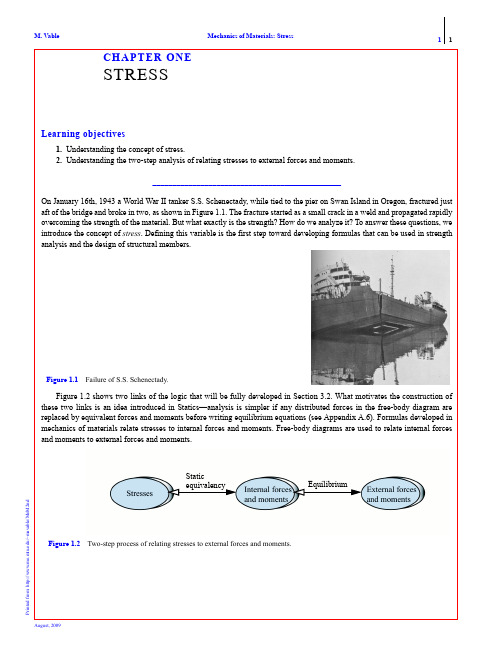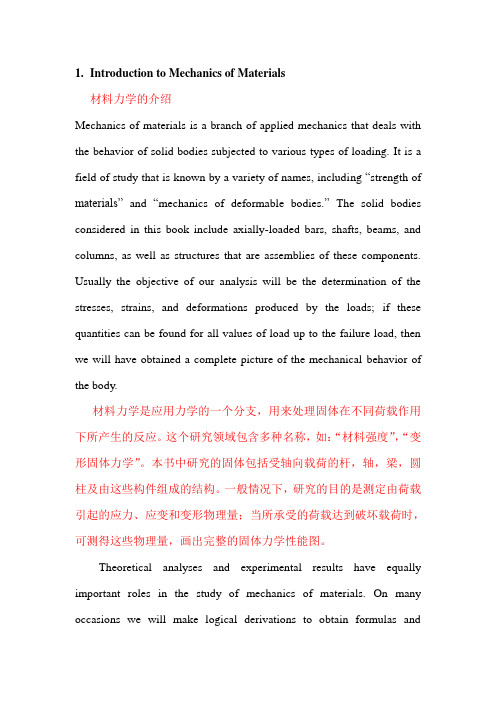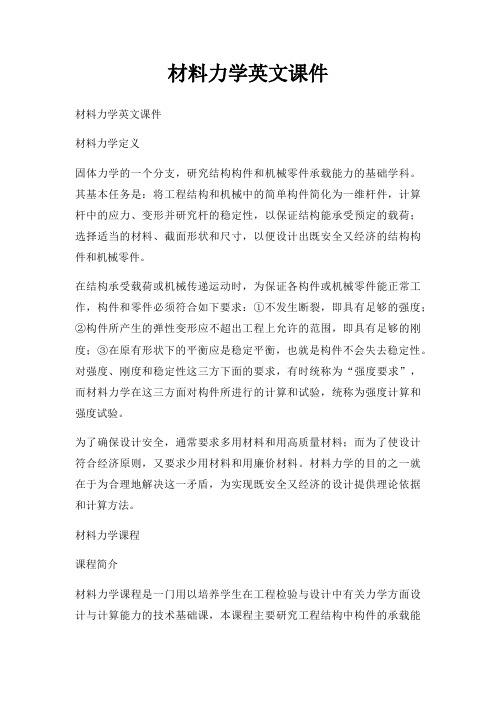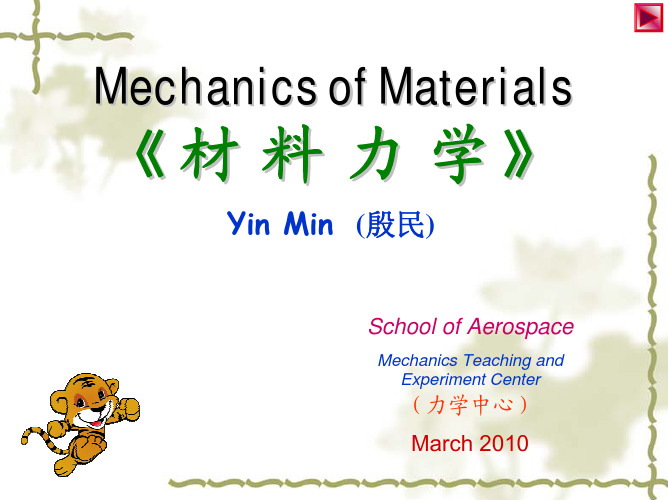材料力学简介(英文)PPT课件
- 格式:ppt
- 大小:236.50 KB
- 文档页数:11

材料力学英语。
Material Mechanics is an applied science focusing on the behavior of solids subjected to various external loads or forces. It is a branch of mechanics that studies the relationship between the internal forces and moments in a material body and the response of said materials in terms of strain, stress, and deformations. The primary aim is to predict the mechanical response of different materials when exposed to load or force.Material mechanics is a highly technical field. It is based on mathematical models and physical principles, such as conservation of energy, view of forces and moments, and equilibrium conditions. Most mechanical properties of materials are determined by experiment, such as the tensile strength, fracture resistance, and fracture toughness. By combining mechanics and materials science, researchers are able to measure and predict material properties such as strength and ductility.Material mechanics also involves the application of structural dynamics, which involves the use of mathematical models and numerical methods to analyze how loads and stresses affect structures. This includes determining how structures are affected when subjected to cyclic loading, seismic vibrations, and other dynamic phenomena.Computer-based modeling techniques are increasingly being used in material mechanics to simulate and analyze the response of materials to different loading conditions. Thesemodels allow for detailed examination of a structure's behavior, enabling engineers to more accurately predict how a structure will respond to different loading conditions.Material mechanics is used in a wide range of industries, particularly in aeronautical, aerospace, and automotive engineering. It is also commonly used in manufacturing processes, such as the manufacture of electronic and electronic components, as well as in civil engineering, where it is used to determine the structural integrity of buildings and other structures. In addition, material mechanics plays an important role in the study of sports and recreation, as well as in medical science, where it is used to design orthopedic implants and prosthetics.。


1.Introduction to Mechanics of Materials材料力学的介绍Mechanics of materials is a branch of applied mechanics that deals with the behavior of solid bodies subjected to various types of loading. It is a field of study that is known by a variety of names, including “strength of materials”and “mechanics of deformable bodies.”The solid bodies considered in this book include axially-loaded bars, shafts, beams, and columns, as well as structures that are assemblies of these components. Usually the objective of our analysis will be the determination of the stresses, strains, and deformations produced by the loads; if these quantities can be found for all values of load up to the failure load, then we will have obtained a complete picture of the mechanical behavior of the body.材料力学是应用力学的一个分支,用来处理固体在不同荷载作用下所产生的反应。
这个研究领域包含多种名称,如:“材料强度”,“变形固体力学”。

材料力学英文课件材料力学英文课件材料力学定义固体力学的一个分支,研究结构构件和机械零件承载能力的基础学科。
其基本任务是:将工程结构和机械中的简单构件简化为一维杆件,计算杆中的应力、变形并研究杆的稳定性,以保证结构能承受预定的载荷;选择适当的材料、截面形状和尺寸,以便设计出既安全又经济的结构构件和机械零件。
在结构承受载荷或机械传递运动时,为保证各构件或机械零件能正常工作,构件和零件必须符合如下要求:①不发生断裂,即具有足够的强度;②构件所产生的弹性变形应不超出工程上允许的范围,即具有足够的刚度;③在原有形状下的平衡应是稳定平衡,也就是构件不会失去稳定性。
对强度、刚度和稳定性这三方下面的要求,有时统称为“强度要求”,而材料力学在这三方面对构件所进行的计算和试验,统称为强度计算和强度试验。
为了确保设计安全,通常要求多用材料和用高质量材料;而为了使设计符合经济原则,又要求少用材料和用廉价材料。
材料力学的目的之一就在于为合理地解决这一矛盾,为实现既安全又经济的设计提供理论依据和计算方法。
材料力学课程课程简介材料力学课程是一门用以培养学生在工程检验与设计中有关力学方面设计与计算能力的技术基础课,本课程主要研究工程结构中构件的承载能力问题。
通过材料力学的学习,能够对构件的强度、刚度和稳定性问题具有明确的基本概念,必要的基础知识,比较熟练的计算能力,一定的分析能力和初步的实践能力。
材料力学课程是高等工科院校中土木工程专业一门主干专业课程。
在教学过程中要综合运用先修课程中所学到的有关知识与技能,结合各种实践教学环节,进行土木工程毕业生所需的基本训练,为学生进一步学习有关后续专业课程和有目的从事工程检验与设计工作打下基础。
因此材料力学课程在土木工程专业的教学计划中占有重要的地位和作用。
课程目标材料力学是由基础理论课过度到专业课程的技术基础课。
通过该课程的学习,要求学生对杆件的强度、刚度和稳定性问题具有明确的基本概念、必要的基础知识、比较熟练的计算能力、一定的分析能力和初步的实验能力。


材料力学双语教学学习资料1 主讲教师:陈晓峰第一章绪论Chapter 1 Introduction§1-1 材料力学的任务The Tasks of Mechanics of Materials1*. 材料力学: Mechanics of Materials2. 构件: Structural Members3. 变形: Deformation4*. 强度: Strength5*. 刚度: Rigidity6*. 稳定性: Stability§1-2 变形固体的基本假设Fundamental Assumptions of SolidDeformation Bodies1. 连续性假设: Continuity2. 均匀性假设: Homogeneity3. 各向同性假设: Isotropy§1.3 外力及其分类External Forces and Classification1. 分布力: Distributed Force2. 集中力: Point Force3. 静载荷: Static Load4. 动载荷: Dynamic Load§1.4 内力、截面法和应力的概念Concepts of Internal Forces,Method ofSection and Stress1*. 内力: Internal Force2*. 截面法: Method of Section3. 截面法的三个步骤:截开,代替,平衡Three steps of method of section: cut off, substitute , and equilibrium.4*. 应力: Stress5. 平均应力:Average stress6. 应力(全应力):Whole stress(sum stress)7*. 正应力: Normal Stress8*. 剪应力(切应力):Shearing Stress§1.5 变形与应变Deformation and Strain1.线应变: Strain2.剪应变: Shearing Strain§1.6 杆件变形的基本形式Basic Types of Deformations of Rods1*. 拉伸或压缩: Tension or Compression2*. 剪切: Shear3*. 扭转: Torsion4*. 弯曲: Bending第二章拉伸、压缩与剪切Chapter 2 Tension,Compression andShear§2.1 轴向拉伸与压缩的概念和实例The Concept and Examples of AxialTension and Compression1. 拉杆: Tensile Rod2. 压杆: Compressive Rod3. 受力特点:外力合力的作用线与杆轴线重合Characteristic of the External Forces: The acting line of the resultant of external forces is coincided with the axis of the rod.4. 变形特点:杆沿轴向伸长或缩短Characteristic of Deformation: Rod will elongate or contract along the axis of the rod.§2.2 轴向拉伸或压缩时横截面上的内力和应力Internal Force and Stress of Axial Tensionor Compression on the Cross Section 1*. 横截面: Cross Section 2*. 轴力: Normal Force 3*. 轴力图: Diagram of Normal Force§2.3 直杆轴向拉伸或压缩时斜截面上的应力Stress of Axial Tension or Compressionon the Skew Section1. 斜截面: Skew Section2. ασσα2cos = αστα2s i n 2=§2.4 材料在拉伸时的力学性能Mechanical Properties of Materialswith Tensile Load1. 标准试件: Specimen2. 低碳钢(C ≤0.3%): Low Carbon Steel3. 弹性阶段:Elastic Region4. 屈服阶段:Yielding Stage5. 强化阶段:Hardening Stage6. 颈缩阶段: Necking Stage 7*.σp ----比例极限: Proportional Limit 8*.σe ----弹性极限: Elastic Limit 9*.σs ----屈服极限: Yielding Stress 10*.σb ----强度极限: Ultimate Stress 11. 延伸率: Percent Elongation12. 断面收缩率: Percent Reduction of Area 13. 塑性材料: Ductile Materials 14. 脆性材料: Brittle Materials 15. 铸铁:Cast iron§2.7 失效、安全系数和强度计算 Failure, Safety factor and Strengthcalculation1*. 许用应力: Allowable Stress 2. 安全系数: Safety Factor 3*. 强度条件: Strength Condition][max σσ≤=AF N4*. 强度校核: Check strength][max σσ≤5*. 截面设计: Section design][σNF A ≥6*. 确定许可载荷:Determine allowable load][σA F N ≤§2.8 轴向拉伸或压缩时的变形 Deformation in Axial Tension orCompression1. 弹性变形: Elastic Deformation2. 塑性变形: Plastic Deformation3. 纵向应变: Longitudinal Strainlll l l -=∆=1ε 4. 横向应变: Lateral Straindd d d d -=∆=''ε5.线弹性变形:Linear Elastic Deformation6.泊松比:Poisson’s ratioεεμ'=7*.弹性模量-E :表示材料抵抗拉压变形的 能力 E - modulus of elasticity :Indicates the capability of materials for resisting tension or compression 8*.抗拉刚度-EA :表示构件抵抗拉压变形的能力EA -the axial rigidity: Indicates the capability of constructive members for resisting tension or compression 9*. 胡克定律(Hooke’s Law ):当应力不超过材料的比例极限时,应力与应变成正比.The stress is proportional to the strain within the elastic region.εσE =EA L F L N=∆§2.12 应力集中的概念The Concept of Stress Concentration 1.由于截面尺寸的突然变化,使截面上的应力分布不再均匀,在某些部位出现远大于平均值的应力,称应力集中。